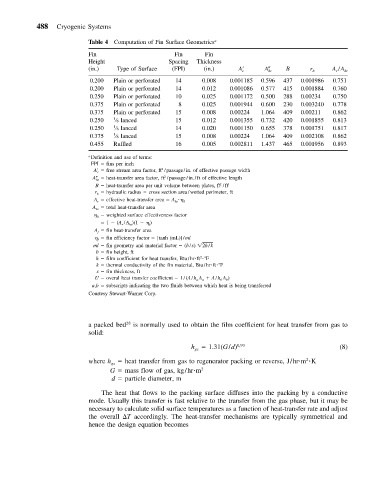Page 499 - Mechanical Engineers' Handbook (Volume 4)
P. 499
488 Cryogenic Systems
Table 4 Computation of Fin Surface Geometrics a
Fin Fin Fin
Height Spacing Thickness
(in.) Type of Surface (FPI) (in.) A c A ht B r h A r /A ht
0.200 Plain or perforated 14 0.008 0.001185 0.596 437 0.001986 0.751
0.200 Plain or perforated 14 0.012 0.001086 0.577 415 0.001884 0.760
0.250 Plain or perforated 10 0.025 0.001172 0.500 288 0.00234 0.750
0.375 Plain or perforated 8 0.025 0.001944 0.600 230 0.003240 0.778
0.375 Plain or perforated 15 0.008 0.00224 1.064 409 0.00211 0.862
0.250 1 ⁄8 lanced 15 0.012 0.001355 0.732 420 0.001855 0.813
0.250 1 ⁄8 lanced 14 0.020 0.001150 0.655 378 0.001751 0.817
0.375 1 ⁄8 lanced 15 0.008 0.00224 1.064 409 0.002108 0.862
0.455 Ruffled 16 0.005 0.002811 1.437 465 0.001956 0.893
a Definition and use of terms:
FPI fins per inch
2
A free stream area factor, ft /passage/in. of effective passage width
c
2
A heat-transfer area factor, ft /passage/in./ft of effective length
ht
2
B heat-transfer area per unit volume between plates, ft /ft 3
r hydraulic radius cross section area/wetted perimeter, ft
h
A effective heat-transfer area A 0
r ht
A total heat-transfer area
ht
weighted surface effectiveness factor
0
1 (A /A )(1 ) f
r ht
A fin heat-transfer area
f
fin efficiency factor [tanh (mL)]/ml
f
ml fin geometry and material factor (b/s) 2h/k
b fin height, ft
2
h film coefficient for heat transfer, Btu/hr ft F
k thermal conductivity of the fin material, Btu/hr ft F
s fin thickness, ft
U overal heat transfer coefficient 1/(A/hA A/hA )
a
a
b
b
a,b subscripts indicating the two fluids between which heat is being transferred
Courtesy Stewart-Warner Corp.
a packed bed 28 is normally used to obtain the film coefficient for heat transfer from gas to
solid:
h 1.31(G/d) 0,93 (8)
gs
2
where h heat transfer from gas to regenerator packing or reverse, J/hr m K
gs
G mass flow of gas, kg/hr m 2
d particle diameter, m
The heat that flows to the packing surface diffuses into the packing by a conductive
mode. Usually this transfer is fast relative to the transfer from the gas phase, but it may be
necessary to calculate solid surface temperatures as a function of heat-transfer rate and adjust
the overall T accordingly. The heat-transfer mechanisms are typically symmetrical and
hence the design equation becomes

